Abstract
Atriums play an irreplaceable role within the plan of modern commercial buildings. However, the presence of skylights makes the atrium suffer from unfavorable conditions such as overheating, high energy consumption, and glare, which can be partially reduced by the sun-shading design of skylights. In this paper, we conducted a field test and questionnaire survey on the daylight quality of commercial buildings in cold zones in China to find out the current problems of daylight quality in atriums and to establish a model of commercial atrium. After the dynamic daylight and energy consumption simulation, the sensitivity analysis of daylight and energy performance is performed for the skylight and shading (SAS) design parameters under three shading types. Finally, the Pareto front solution set of optimized commercial atrium daylight, visual comfort, and energy performance for the three shading types has been obtained using a multi-objective search tool. The results show that SRR has the greatest effect on sDA, DGP, and EUI in all shading cases; while SGT has a greater effect on EUI than on daylight quality; FC has a greater effect on EUI than FV on EUI; and LS and LI have a more significant influence on daylight and visual comfort. The optimal SAS values of no shading, fabric shading and louvered shading were screened as SRR is 0.4–0.5, SGT is Double silver Low-E insulating glass; SRR is 0.5–0.6, SGT is Double silver Low-E insulating glass, FV is 0.5–0.7, FC is 0.5–0.6; SRR is 0.6–0.7, SGT is Double silver Low-E insulating glass, LS is 100 mm/125 mm, and LI is 60–70°. It is expected that this study will provide some information and reference for the design of commercial atriums in cold zones in the future.
1. Introduction
With commercial prosperity and economic development, more and more commercial buildings are being constructed in China [1,2]. They use brilliant lighting to attract customers to shop and spend money, but at the same time electric lighting consumes a lot of energy (electric lighting accounts for about 20–30% of the total energy consumption of commercial buildings), and much of this lighting energy consumption may be reduced or avoided [3]. Studies have demonstrated that energy-related carbon emissions from commercial buildings are 1.62 times greater than those from residential buildings [4]. While lighting at night for visual effects may be impossible to avoid, daytime lighting needs can often be met by bringing in outside sunlight through atrium skylights, which allows the atrium to save significant lighting energy for commercial buildings [5,6,7,8], and in some old commercial buildings, the application of manufactured lighting creates warmth and, therefore, increments the cooling load, representing approximately 3–5% of the total energy consumption. However, with the widespread use of LEDs, this problem has been properly solved. It is important to reduce the use of artificial lighting to reduce the total power consumption of commercial buildings [9,10,11]. Although the atrium can bring sufficient daylight and solar radiation to the building, many factors such as the poor heat transmission performance of the skylight, the large volume of the atrium, and the large amount of light entering the atrium can cause adverse conditions like overheating in summer, heat dissipation in winter, high energy consumption, and glare [12]. Indoor visual comfort is also a major concern in interior design, mainly related to controlling the discomfort glare by daylight [13,14]. It is because of these issues that atrium designs usually employ appropriate shading designs to control the adverse effects of the sun on the atrium [15,16]. However, excessive shading design can also compromise the benefits provided by atrium skylights [17]. Changing skylight and shading (SAS) design parameters during the design phase has different effects on optimizing the daylight and energy performance of commercial atriums [11,18]. Studies of atrium skylight design and shading design have always been considered separately before [6,7,19], which requires architects and designers to consider the effects of skylight and shading design parameters on commercial atriums in an integrated manner and may result in contradictions that can lead to uncomfortable light environments and energy wastage in commercial atriums [20]. Therefore, this paper focuses on the combined effect of SAS design parameters on daylight, visual comfort, and energy performance of commercial atriums.
The atrium plays an essential role in commercial buildings, and the active and abundant daylight space makes the atrium a modern trend in commercial architectural design [6,21], which is also welcomed by clients and consumers [22,23], as shown in Figure 1. The skylight is the most critical part of the atrium, which usually uses transparent materials to provide natural light and solar radiation. People spend about ninety percent of their day indoors [24], and natural light can create a healthy and comfortable indoor light environment for users, which is very beneficial for commercial buildings to attract customers and create more marketable value [1,25,26]. Studies have shown that natural daylight and solar radiation have a positive impact on the physiology, psychology, and work efficiency of users [27,28,29,30] and that daylight can also improve visual perception and synchronization of circadian stimuli in the human body, thereby improving spatial comfort and user health [31,32,33]. Shading devices that are widely used in atriums can prevent overly bright atrium daylight and large amounts of solar radiation in the summer [34,35]. Shading systems, as a detached design technique, play an imperative part in building energy utilization and indoor visual comfort [36,37,38], and universal types of shading include fabric shading and louvered shading [39,40]. Unshaded designs for atrium skylights are also a common type [41]. Nielsen et al. [42] investigated three types (no shading, fixed shading, and dynamic shading) of façade shading to explore their effects on building energy consumption and daylight factors, observing and comparing the performance of the three shading types. K. Day et al. [43] investigated three large commercial office classes in the United States’ three shading strategies and found that occupants with better satisfaction with daylight tended to have better productivity and satisfaction. Koç et al. [44] investigated the impact of settled shading devices on building energy performance in office buildings within the Mediterranean locale and analyzed the impact of parameters such as utilizing the orientation, glass sort, window-to-wall ratio, depth, and incline of shading devices on building energy. The results show that all studied parameters have a large impact on annual energy consumption. Therefore, when considering the design of shading systems, it is important to consider not only the type of shading but also additional building parameters. The atrium daylight quality includes both objective measurements and subjective customer experience, and it is important and attractive that commercial atriums have natural light and are preferred by customers [45]. In this paper, we conducted a survey study on the daylight quality of commercial atriums to analyze the current client fulfillment with the daylight quality of commercial atriums in cold zones and the conceivable issues that still exist in commercial atrium daylight.
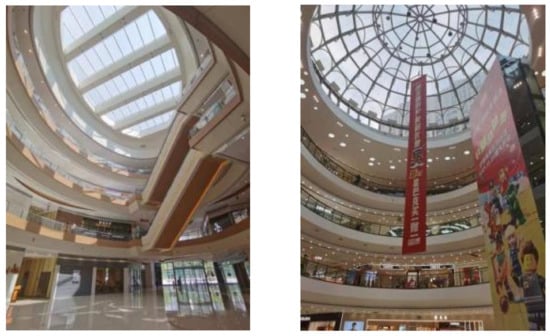
Figure 1.
Commercial building atrium photos (Author self photography)).
The building sector accounts for about one-third of the world’s carbon dioxide emissions, and the development of green and sustainable buildings is becoming a mainstream idea in architectural design [46,47]. Large public buildings in China consume much more energy than other types of buildings. The atrium, as a frequently used space in public buildings, provides a space for people to gather and communicate and provides natural daylight and solar radiation to the building interior [27,35,48], but it also causes a large amount of energy consumption [8]. Many studies on atriums are now available, as shown in Table 1, but most of them are single-objective studies on atrium shape, skylight design configuration, etc. for daylight or energy consumption [5,7]. It can be seen from Table 1 that some early studies prefer to use DF, illuminance, and other static daylight evaluation indicators, while recent studies prefer to use dynamic daylight evaluation indicators such as sDA, ASE, and UDI as optimization objectives. One reason for this is that these indicators use 8760 h as the evaluation dimension, which can better reflect the daylight performance of buildings throughout the year [9,18,19,27]. The multi-objective optimal design has the advantage of being more convenient and accurate for conflicting research objects. De Luca et al. [34] used a multi-objective optimization tool to study static shading in Estonian Tallinn classrooms, analyzing the role of shading devices on the effects of built daylight, glare, view, and energy use, and seeking a Pareto-front solution set. Results showed that static shading reduced visual discomfort by 89.8%, while reducing primary energy use by 29.1%, and providing adequate daylight and visibility. Fan et al. [49] conducted a multi-objective optimization study on the shading rate of an exercise room, proposing to achieve a balanced optimization between two conflicting objectives of light comfort and solar radiation, and exploring the role of façade shading design parameters on the optimization objectives. Ziaee et al. [50] investigated the impact of the light-shelf on the multi-objective optimization of lighting and thermal consolation, and found that WWR and rotation angles have different degrees of influence in different climatic conditions. Khidmat et al. [51] proposed a parametric and multi-objective optimization-based approach to study the sun shading performance of Japanese metal panels and improved the ASE and UDI indexes of building interiors by exploring the design parameters of metal panels that optimized the building’s light environment. To reduce the adverse effects of solar radiation on the atrium, shading is usually designed at the atrium skylight, and the skylight with shading (SAS) has a significant impact on the daylight, visual comfort, and energy performance of the atrium. For these three objectives, there are often conflicting requirements in atrium design. In previous studies, the goal was usually to explore the interaction between lighting and visual comfort or the interaction between daylight and energy performance. Few studies consider the interaction of the three at the same time. Optimizing the lighting of commercial atriums often means increasing the risk of visual discomfort and atrium energy consumption. Therefore, the use of multi-objective optimization tools can more accurately, scientifically, and quickly obtain the best optimization scheme for lighting, visual comfort, and energy performance [11,34,43,52,53]. The main studies in this paper have been:

Table 1.
Atrium Research Literature.
- (1)
- Field testing and a questionnaire survey of commercial building atriums in cold zones in China to present the existing problems of atriums.
- (2)
- Setting SAS design parameter variables to establish a parametric model of commercial atriums in cold zones.
- (3)
- Using Ladybug + honeybee to conduct daylight, glare, and energy consumption simulations to analyze the SAS design parameters of the atrium under three shading types.
- (4)
- Using the multi-objective search tool Octopus to calculate the Pareto front solution set to obtain the SAS parameters for optimal daylight, visual comfort, and energy performance.
2. Methodology
The paper is focused on optimizing the design of atrium skylight and shading (SAS) parameters for commercial buildings in cold zones in China and conducting a multi-objective optimization of atrium daylight, visual comfort, and energy performance. Using field tests, questionnaires, literature searching, and software simulations, we found the existing light environment problems of typical commercial atriums in cold regions and investigated the energy consumption structure of commercial atriums by using energy simulation software. Finally, we obtained the optimal Pareto front solution set for daylight, visual comfort, and energy performance under different shading types. The detailed technical route of the study is shown in Figure 2.
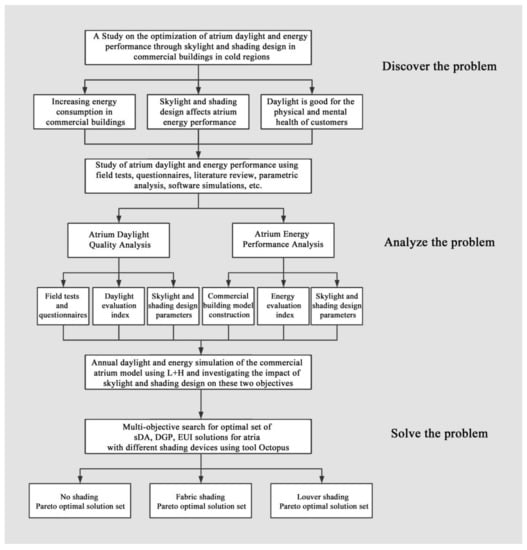
Figure 2.
Technology research route.
2.1. Commercial Atrium Daylight Field Study
2.1.1. Cold Zone
The cold zone of China is found in the northern part of China, which needs both winter thermal preservation and summer thermal insulation. The basis for the division of cold areas is the “Thermal design code for civil building” (GB-50176-2016), in which cold areas are defined as one of the five climatic zones in China where the coldest monthly average temperature in China meets −10~0 °C and the daily average temperature is less than or equal to 5 °C for 90~145 days. The climatic characteristics of cold zones are long, cold, and dry winters, hot and humid summers in the plain area, cool summers in the plateau area, and relatively concentrated precipitation. The annual temperature difference is large, and the sunshine is rich. Spring and autumn are short and the temperature changes dramatically. Rain and snow are rare in spring, windy and sandy weather is strong, and hail and thunderstorms are frequent in summer and autumn.
This paper chooses Jinan, China as the location of this consideration, which is found within the cold zone of China, and the daylight zoning is in three zones. The chamber of a commercial building in Jinan has been chosen as the inquiry. The question will explore the optimization of the commercial chamber daylight within the cold locale of China. The foremost commonly utilized strategy to assess daylight execution is climate-based daylight modeling (CBDM): a daylight forecast that demonstrates that employments sun-based and sky conditions from meteorological datasets to define various brilliant amounts and an energetic approach based on hour-by-hour genuine daylight climate information all through the year [57]. CBDM gives an assortment of markers to assess daylight execution, such as Spatial Daylight Autonomy (sDA), Annual Sunlight Exposure (ASE), and Useful Daylight Illuminance (UDI) [28,48,58]. The record downloaded from https://energyplus.net/weather (accessed on 23 November 2021) Shandong Jinan (CSWD) has been utilized as the climate record for daylight recreation consideration. The CSWD file contains the annual climate conditions in Jinan, Shandong Province, including the annual illumination data.
2.1.2. Test Objects and Settings
In this consideration, a closed four-way atrium is chosen. Compared with other shapes of atrium spaces, this frame of atrium space is associated with the insides in all four bearings. It was the bay window light roof through which the light enters, without side windows to help the daylight, which is the foremost unfavorable circumstance for the indoor lighting environment. At the same time, this shape prohibits the impact of side windows, which permits a more in-depth consideration of the impact of SAS design on atrium daylight and energy utilization.
The test in question is the atrium in a commercial building in Jinan, China, which is around 252 m long, 117 m wide, and 30 m tall with 5 floors. there are three four-way encased atriums within the shopping center, and the atrium’s arranged shape is almost rectangular, 45 m long and 36 m wide. the genuine photo and arranged graph of the atrium appear in Figure 3 concurring with the “Method of daylighting measurements, GB/T5699 Beijing: Standards Press of China” The test time was 6 January 2022, from 10:00 a.m. to 16:00 p.m. The fully cloudy weather near the winter solstice was chosen to measure the most unfavorable conditions of daylight in the atrium and to provide data to support daylight optimization later on. The climate was fully cloudy, and the test instrument was the FLUKE-941 illuminance meter, which is small, simple to carry, and conducive to hand-held estimation and real-time recording of illuminance values at estimation focuses. The test was done in the atrium along the length and width of the direction of the uniform arrangement of measurement points. The measurement point spacing was about 8 m, we set five measurement points according to the shopping mall indoor boundaries, which are about 8 m, along the atrium axis direction to generate five horizontal and five longitudinal test sections. The measurement from the ground is 0.75 m high on the horizontal surface as a reference plane, as shown in Figure 4.
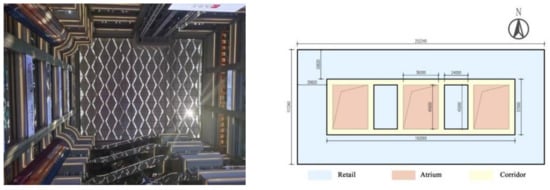
Figure 3.
Atrium photo and floor plan diagram (Author self photography).
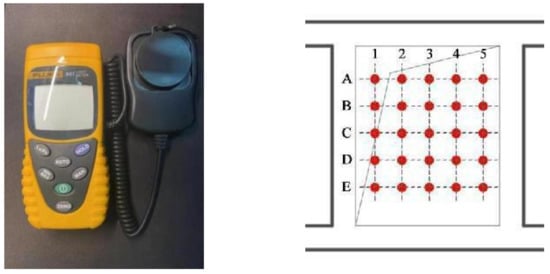
Figure 4.
Test equipment and measuring point layout.
2.1.3. Measurement Results
After the test, the detailed measurement data are shown in Figure 5 and Table 2. From the results, it can be seen that the normal indoor illuminance from 11:00 to 13:00 is high, and after 13:00 shows a gradual decline. After 15:00, the illuminance is close to 1000 lx or less, which must be supplemented by manufactured lighting. According to Figure 5, the illuminance distribution of the coordinates before 14:00 has obvious directionality, and the illuminance of the coordinates on the west side of the plane are higher than that of the coordinates on the east side.
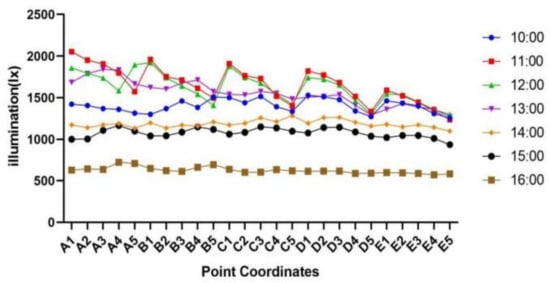
Figure 5.
Coordinate diagram of atrium illuminance measurement values.

Table 2.
Atrium illumination measurement results.
2.2. Commercial Atrium Daylight Quality Questionnaire Survey
2.2.1. Questionnaire
A questionnaire survey on atrium daylight quality has been conducted in a test commercial building atrium. The questions are related to the subjective perception of the daylight environment of the commercial atrium. Six representative questions were chosen, and each question was divided into five levels according to its degree, with levels one to five being defined as not at all, less, average, more, and fully. The questionnaire survey was conducted from 6–8 January 2022, and 224 valid questionnaires were received from randomly selected customers in the indoor atrium and entrance hall, with the questions as Figure 6.
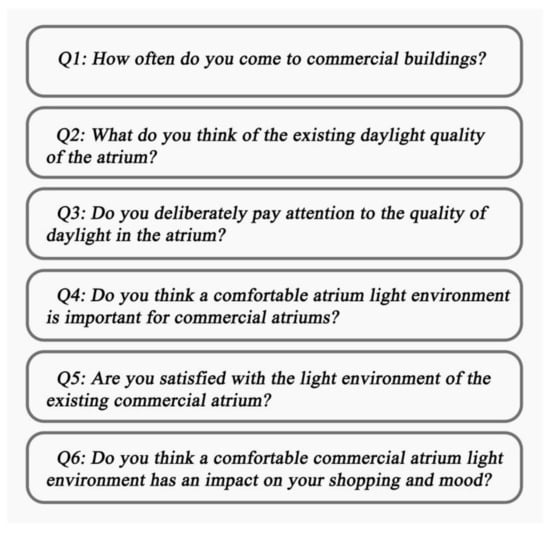
Figure 6.
Questionnaire questions.
2.2.2. Survey Results
As Figure 7 shows, there are more female customers than male customers in commercial buildings, and the age group is mainly 20, 30, and 40, which is relatively young; the score of each of the six questions is above 3, which indicates that customers attach more importance to the light environment in the atrium of commercial buildings. The highest score is Q4 with 4.2 points, which indicates that customers generally believe that a comfortable atrium light environment is very important for the atrium of commercial buildings. The lowest scores are Q1 and Q3, with 3.04 and 3.09, respectively, indicating that there is still room for improvement in customers’ concern for the quality of daylight in commercial atriums. From the overall results, a comfortable atrium light environment is very significant for customer satisfaction.
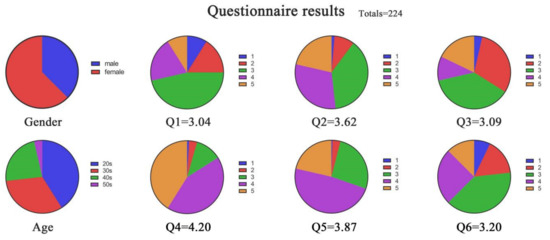
Figure 7.
Questionnaire results.
Q1: Most customers choose the average level, which indicates that commercial buildings are in a moderate position for people’s lives. It can be seen that most customers come to commercial buildings for shopping and leisure in their spare time, and the frequency is not too high nor too low. Q2: Most customers choose options 3 and 4, which indicates that most customers think that the current natural daylight of the commercial atrium is relatively ordinary or slightly bright. Q3: Most customers have chosen options 2 and 3, which indicates that at present, customers will not pay too much attention to the natural daylight quality of the commercial atrium but will maintain a moderate attitude. It can be seen that customers do not have a more systematic and complete concept of the quality of natural daylight in commercial atriums. However, the proportion of options 4 and 5 also has a certain proportion, which indicates that some customers have deliberately begun to pay attention to the natural daylight quality of the commercial atrium during the shopping process, and also indicates that the natural daylight quality of the commercial atrium gradually plays a subjective role in the commercial shopping activities of customers. Q4: Most customers choose options 4 and 5, which indicates that most customers still think that a comfortable natural daylight environment in the commercial atrium is very important for commercial buildings. A comfortable and bright daylight environment in the commercial atrium will have a positive effect on commercial buildings. Q5: Most customers choose option 4, which indicates that they are basically satisfied with the current situation of natural daylight in the commercial atrium, but there is still room for improvement, indicating that there is still room for improvement in the subjective perception of natural daylight to customers. Q6: Most customers choose Option 3, which means that some customers think that natural daylight has little impact on their shopping, but a certain proportion of customers also tend to have an impact, which means that customers begin to pay more attention to the subjective emotional effect of natural daylight in the commercial atrium on shopping activities.
As Figure 7 shows, according to the results of the questionnaire survey, the daylight quality and light environment comfort of the commercial atrium are of great significance for customers to come to the commercial buildings for shopping and leisure. And the current subjective questionnaire survey results of commercial atrium daylight quality still have shortcomings, which need to be improved in the next step to improve the atrium daylight quality and customer satisfaction.
2.3. Commercial Building Atrium Baseline Model
After obtaining the atrium’s real measurement data and the atrium daylight quality questionnaire results, a baseline of commercial building atriums in the cold zone is set up. The advantage of using Rhino + Grasshopper as the modeling software is that it can realize parametric modeling and provide an operation platform for the following SAS design parameters study. The baseline model is shown in Figure 8, which is built based on the measured commercial atrium, and the detailed model parameters are shown in Table 3. The atrium model was simulated using the Ladybug + Honeybee (L + H) plug-in for daylight, glare, and energy consumption, with EnergyPlus, Dayism, and Radiance as built-in simulation tools. The model was then simulated for illumination, and correlation analysis was performed with the data to determine the reliability of the model daylight simulation.
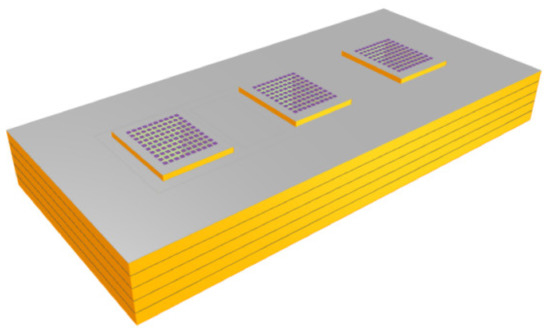
Figure 8.
Commercial atrium baseline model.

Table 3.
Baseline model parameter settings.
The atrium model is simulated for daylight, glare, and energy consumption using the Ladybug + Honeybee (L + H) plug-in, with L + H’s built-in EnergyPlus, Dayism, and Radiance as simulation tools. The demonstration is, at that point, simulated for brightening, and the relationship is confirmed with the measured information to decide the unwavering quality of the model’s daylight simulation. The results are in Figure 9. From the figure, it can be seen that the simulated atrium illuminance values are for the most part lower than the measured atrium, but the curve fit with time is high, R² = 0.9257, and the correlation analysis results show a significant correlation, which can prove the reliability of the baseline model and pass the daylight simulation verification. (The generally low simulated atrium illuminance values may be due to the dense grid calculated in the simulation and the test points spread all over the atrium plane. However, the actual measurement was only conducted in the center of the atrium where the quality of daylight is good, and the lower illuminance at the edge of the atrium was not counted in the measurement data, so the average illuminance obtained was significantly higher than the simulated illuminance data).

Figure 9.
Baseline model daylight verification.
2.4. SAS Design Variable Settings
According to the investigation of commercial building atriums, most commercial atriums have skylights, and a few of them are designed without skylights. The daytime and nighttime daylight of atriums without skylights are basically based on artificial lighting, which isn’t included in the scope of this study. Among the commercial atriums with skylights, according to the research results, there are mainly three types of shading: (1) no shading design; (2) fabric shading; and (3) louver shading, as shown in Figure 10. Therefore, this study categorizes these three types of shading and seeks the optimal SAS design parameters under each type.

Figure 10.
Commercial atrium shading types (Author self photography).
SAS design parameters are divided into two parts, one part is skylight design parameters, and the commonly used design parameters are skylight roof ratio (SRR), skylight glass transmittance, and skylight U-value. Still, since each glass type has its own unique physical characteristics, there is a correlation between the transmittance, SHGC, and U-value of skylight glass. It is not possible to consider these parameters separately, so the skylight glass type (SGT) is selected as one of the study variables [19]. In this study, SRR and SGT are selected as the study objectives in terms of skylight design parameters, as shown in Table 4, and the detailed parameters of SGT are shown in Table 5.

Table 4.
Skylight design parameters.

Table 5.
Skylight glass detailed parameters.
The other part is the shading design parameters. The no-shading design means that there is no shading device on the skylight, so there is no design parameter. Fabric shading refers to the use of transparent materials such as fabrics and roller blinds as shading devices. The visible light transmittance (FV) of materials for fabric shading and the fabric shading coverage (FC) have been selected as research variables in this study. Louver shading is the installation of louvered roller blinds on skylights as shading devices. Usually, the use of louvers can be adjusted in position and tilt point agreeing to the user’s inclination. Still, as a shading device for skylights, the state of the louvers can be ignored for a long time and lead to invariance [15,41]. The louvers’ sizes (LS) and the louvers’ inclination (LI) have been selected as the study parameters. The detailed study parameters are taken in the range shown in Table 6, and the LS is divided into five categories of sizes, which are 50 mm, 75 mm, 100 mm, 125 mm, and 150 mm.

Table 6.
Shading design parameters.
2.5. Daylight and Energy Performance Evaluation
2.5.1. Annual Daylight Evaluation Index
Daylight illuminance was frequently utilized as an assessment list in prior a long time with daylight calculate (DF), whereas energetic daylight assessment indexes have been broadly utilized in daylight performance ponders for a long time, commonly DA, sDA, UDI, ASE, etc. [31]. The DA list was initially proposed by the Swiss Electrical Affiliation in 1989 and assist created to degree the rate of involved hours. UDI is characterized as the illuminance falling within the extend of 100–2000 lx extend of illuminance.
This yearly daylight simulation assessment file employments DA as well as sDA to assess the indoor daylight of commercial atriums. The sDA threshold is set to 1000 lx, i.e., sDA1000,50%, due to the high illuminance values and relatively effective daylight in atriums. sDA reference levels are shown in Table 7. The reference basis for the rating evaluation of sDA is “LEED v4”.

Table 7.
sDA rating evaluation.
2.5.2. Glare Evaluation Index
Visual comfort is the center of the indoor daylight plan. The common glare assessment records are DGI, UGR, CGI, VCP, DPG, etc. [59]. Among them, daylight glare likelihood or DGP is considered a sensible index to assess the daylight distress glare, so the glare assessment viewpoint of energetic assessment index is assessed by DGP, which takes under consideration the by and large brightness of the visual field, as well as the impact of the glare source and differentiate [13].
In this manner, the glare assessment index in this simulation considers employments the inconvenience glare likelihood DGP, and the plan open air brightening is consistently set to 60,000 lx. DGP is the glare list utilized to degree the glare caused by daylight, and the condition is as takes after [60]. The detailed values of the DGP glare rating evaluation are shown in Table 8 [60].
where Ev is the vertical eye illuminance [lux]; Ls the luminance of source [cd/m2]; vs the solid angle of source; P is the position index.

Table 8.
DGP glare rating evaluation [60].
2.5.3. Annual Energy Performance Evaluation Index
Yearly energy use intensity (EUI), as a common assessment list of energy performance, reflects the yearly energy consumption value per unit range of the building in kWh/m2/y. In this consideration, the energy use intensity and ideal design of the atrium have been investigated by changing the SAS plan parameters. The particular EUI pointers investigated are cooling, heating, and lighting energy utilization. Cao et al. [61] explored the specialized arrangements for residential buildings based on EUI standards, utilizing multi-objective optimization, multi-criteria choice making, and coordinates arrangements to propose the foremost viable arrangements for energy productivity in private buildings based on EUI shares.
3. Simulation Results
3.1. No Shading Simulation Results
The Skylight roof ratio (SRR) parameter variable is set in the range of 0.10–0.90, and the Skylight glass types (SGT) parameter variable is set to five types (1–5). Detailed parameters are shown in Table 4. The performance results are shown in Figure 11, where 0.1–0.9 SRR and the five types of SGT working conditions have been simulated separately, and the obtained performance results are shown in Figure 12.
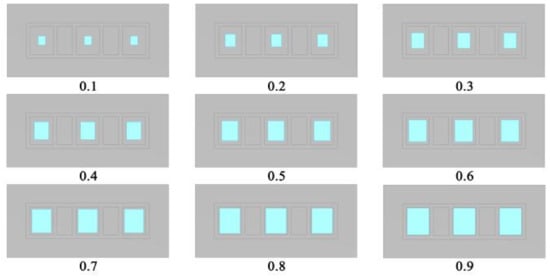
Figure 11.
Skylight roof ratio diagrams.
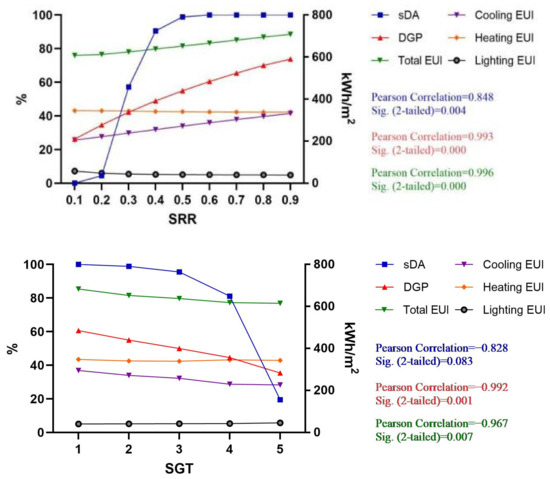
Figure 12.
Simulation results of no shading.
The results show that, for the SRR parameter variables under no shading conditions, sDA and DGP both show a significant positive correlation; the Cooling EUI increases with increasing SRR; the Heating and Lighting EUI decreases with increasing SRR; total EUI and SRR are showing significant positive correlation.
For the SGT parameter variables under no shading conditions: both sDA and DGP showed negative correlations with SGT; the Cooling EUI decreased with increasing SGT due to the U-value of SGT type decreasing significantly; while Heating EUI did not show significant correlation due to increasing SGT type while the U-value with SHGC and VT were also decreasing. Causing a different effect on the Heating and Lighting EUI increases with increasing SGT because the increase of SGT and the decrease of VT leads to the decrease of natural daylight in the room and the increase of lighting energy consumption; total EUI and SGT show a significant negative correlation.
3.2. Fabric Shading Simulation Results
The Fabric Visible transmittance (FV) parameter variable is set in the range of 0.10–0.90, and the Fabric coverage (FC) parameter variable is set in the range of 0.10–0.90, as shown in Table 6. As shown in Figure 13, the working conditions of 0.1–0.9 FV as well as 0.1–0.9 FC, have been simulated separately, and the performance results obtained are shown in Figure 14.
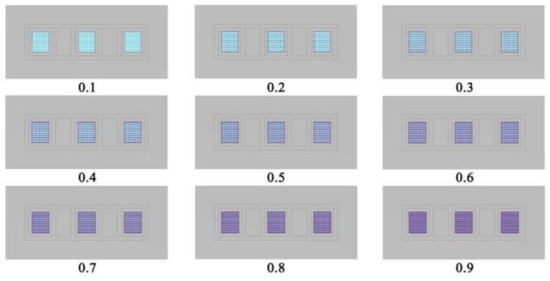
Figure 13.
Fabric coverage diagram.
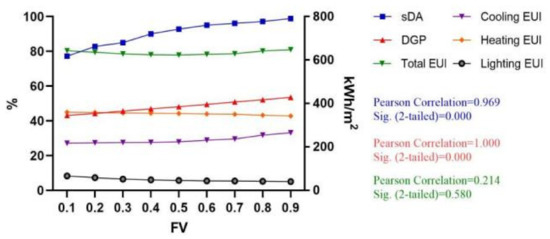
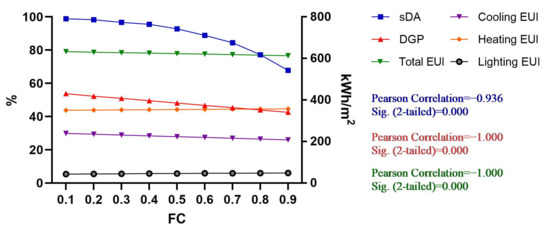
Figure 14.
Simulation results of fabric shading.
The results show that for the FV parameter variables under fabric shading conditions: sDA and DGP both show a significant positive correlation; the Cooling EUI increases with increasing FV; the Heating and Lighting EUI decreases with increasing SRR. However, due to the enhanced solar radiation caused by increasing FV, the energy consumption of Cooling increases and the energy consumption of Heating and Lighting energy consumption decreases, so the total EUI shows a parabolic variation and has no significant linear correlation with the FV parameter.
For the FC parameter variables under fabric shading conditions: sDA and DGP showed a negative correlation with FC; the Cooling EUI decreased as FC increased; the Heating and Lighting EUI increased as FC increased because FC increased and thus reduced solar radiation and visible light transmission, resulting in an increase in EUI. The total EUI shows a significant positive correlation with FC, indicating that the effect of FC on the Cooling EUI is greater than that of the Heating and Lighting EUI.
3.3. Louver Shading Simulation Results
The Louver size (LS) parameter variable is set in the range of five types (1–5) of 50, 75, 100, 125, 150 mm, respectively, and Louver inclination (LI) parameter variable is set in two types (a/b) of clockwise and counterclockwise, 0–90°, respectively, as shown in Table 6. As shown in Figure 15 and Figure 16, LS of which 1–5 and 0–90° LI conditions had been simulated separately, and the performance results were obtained as shown in Figure 17.

Figure 15.
Louver size diagram.

Figure 16.
Louver inclination diagram.
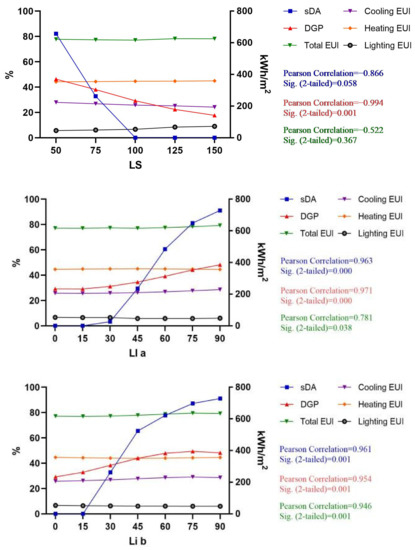
Figure 17.
Simulation results of louver shading.
The results show that for the LS parameter variables under louver shading conditions: sDA and DGP both show positive correlation; the Cooling EUI decreases with increasing LS; the Heating and Lighting EUI increases with increasing LS; the total EUI has no significant linear relationship with LS.
For the LI parameter variables in the louvered condition, the trends are similar for both clockwise and counterclockwise types, with slight differences in the amount of variation, and overall are approximately the same: both sDA and DGP show significant positive correlations with LI; the Cooling EUI increases with increasing LI; while the Heating EUI has no significant correlation. The total EUI showed a significant positive correlation with LI. Since the results presented by the two rotation directions are approximately the same, and the results of clockwise rotation mode are smoother and more uniform, the follow-up study takes the clockwise rotation direction of the louver as the research object.
3.4. Sensitivity Analysis
Sensitivity analysis can distinguish the foremost basic parameters related to building execution and, in this way, economical building plan and optimization can center on this portion of the design parameters. Sensitivity analysis is based on sampling analysis and thus shows the possible range of these performance indices. Sensitivity analysis using multiple linear regression analysis for each study parameter is a more general approach [62]. The use of sensitivity analysis within the early stages of design can make strides toward the productivity of building performance optimization. Relationship investigation and numerous direct relapse conditions are commonly utilized to analyze the information, and standardized regression coefficients (SRC) can give data on the impact of building plan parameters on the optimization measurements of commercial atriums. Sensitivity positioning of key parameters moreover illuminates the design procedure. Combining suitable affectability methods with a building recreation computer program can be a compelling and profitable device for positioning the significance of optimization pointers based on plan parameters in a brief period of time. In recent affectability examinations, the relationship examination of each atrium plan parameter was firs.
The correlation coefficients of the SAS design parameters with the target performance with sig. after simulation are shown in Table 9. The results show that the correlation between SGT, LS, and sDA with sig. >0.005 is relatively insignificant, while there is no significant correlation between FV, LS, and EUI. SRR, FC, and LI have significant correlations with sDA, DGP, and EUI, indicating that SAS plan parameters have diverse impacts on daylight, visual comfort, and energy performance beneath diverse shading conditions. Based on the comes about of the relationship investigation, numerous straight regression conditions are performed for the SAS plan parameters beneath the three shading conditions, to investigate the degree of impact of each SAS plan parameter on the optimization targets.

Table 9.
Correlation analysis of atrium parameters.
Correlation analysis has been performed for each design parameter. The correlation and significance coefficients of each SAS design parameter for the three shading methods have been obtained. The taking after investigative handle included an orthogonal test plan utilizing SPSS, arbitrary inspecting combinations to get the comparing optimization lists, different direct regression examinations to calculate the regression coefficients of each plan parameter, and examination of the degree of impact of SAS plan parameter factors on the markers of atrium daylight, visual comfort, and energy performance of commercial buildings beneath diverse shading strategies. Eighty-one sets of parameter combinations were received from the orthogonal plan and advance-prepared by L + H for building the performance simulation to get the target optimization lists sDA, DGP, and EUI. This information will be brought into SPSS to calculate the comes about of the different direct regression conditions.
B0 is the constant term, 1,2,3……n is called Y corresponding to X1,X2,X3…Xn regression coefficient.
After the simulation, the data results were analyzed by multiple linear regressions, and the following results were obtained.
3.4.1. No Shading Sensitivity Analysis
X1 is Skylight Roof Ratio (SRR), X2 is Skylight Glasses Types (SGT); VIF < 5 shows that there’s no multicollinearity between the parameters. The show residuals, which fundamentally complied with an ordinary dispersion, demonstrated that the mistake of this condition was within a sensible extent. Subsequently, the direct regression equation set up by the show is factually significant.
As appeared in Table 10, the SPSS program was utilized to fit the numerous straight regression and the coefficient of the show fit; The values of R2 0.788, 0.937, 0.845 demonstrating a great show fit, and the values of DW are 1.883, 2.194, 2.116 indicating that there’s no relationship between the autonomous factors in this show, a substantial regression.

Table 10.
No shading SAS design parameters linear regression model.
As Figure 18 illustrates, the standardized coefficients Beta of SRR with sDA, DGP, and EUI are 0.829, 0.818, and 0.700, respectively, which indicates that the SRR parameter has a greater impact on the daylight, visual comfort, and energy performance. The standardized coefficient Beta of SGT with sDA, DGP, and EUI are −0.319, −0.518, and −0.595, respectively, indicating that the SRR parameter has a greater effect on energy performance; followed by SGT on visual comfort, while it has a less effect on annual daylight.
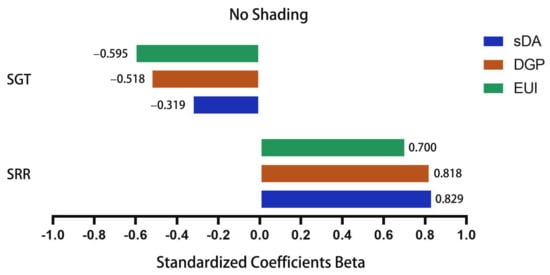
Figure 18.
Sensitivity analysis of no shading commercial atrium SAS design parameters.
- sDA Regression equation:
Y = 0.233 + 1.359X1−0.096X2
- 2.
- DGP Regression equation:
Y = 0.398 + 0.501X1−0.058X2
- 3.
- EUI Regression equation:
Y = 639.722 + 104.677X1−16.249X2
3.4.2. Fabric Shading Sensitivity Analysis
X1 is Skylight Roof Ratio (SRR), X2 is Skylight Glasses Types (SGT); X3 is Fabric Visible transmittance (FV); X4 is Fabric Coverage (FC); VIF < 5 shows that there’s no multicollinearity between the parameters. The show residuals, which fundamentally complied with an ordinary dispersion, demonstrated that the mistake of this condition was within a sensible extent. Subsequently, the direct regression equation set up by the show is factually significant.
As appeared in Table 11, the SPSS program was utilized to fit the numerous straight regressions and the coefficient of the show fit. The values of R2 are 0.750, 0.925, 0.810, demonstrating a great show fit and the values of DW are 1.677, 2.166, 1.974, indicating that there’s no relationship between the autonomous factors in this show—a substantial regression.

Table 11.
Fabric shading SAS design parameters linear regression model.
As can be seen in Figure 19, the standardized coefficients Beta of SRR with sDA, DGP, and EUI under fabric shading are 0.734, 0.776, and 0.636, respectively; the standardized coefficients Beta of SGT with sDA, DGP, and EUI are −0.328, −0.450, and −0.544, respectively; the standardized coefficients Beta of FV with sDA, DGP, and EUI are −0.229, 0.255, and 0.088, respectively; the standardized coefficients Beta of FC with sDA, DGP, and EUI are 0.229, 0.255, and 0.088, respectively; the standardized coefficients Beta of FC with sDA, DGP, and EUI are −0.226, −0.235, and −0.319, respectively. The results show that SRR and SGT are still the more influential parameters in SAS design parameters, but there is a slight difference in the degree of influence compared to the no shading condition. While FV has a less influential role in energy performance, both FV and FC have an impact in terms of daylight and visual comfort.
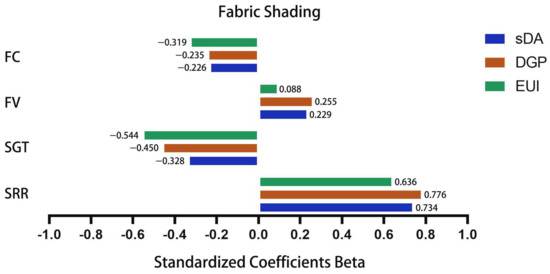
Figure 19.
Sensitivity analysis of fabric shading commercial atrium SAS design parameters.
- sDA Regression equation:
Y = 0.205 + 1.239X1−0.109X2 + 0.386X3−0.381X4
- 2.
- DGP Regression equation:
Y = 0.343 + 0.445X1−0.051X2 + 0.146X3−0.135X4
- 3.
- EUI Regression equation:
Y = 640.096 + 74.685X1−12.537X2 + 10.291X3−37.423X4
3.4.3. Louver Shading Sensitivity Analysis
X1 is Skylight Roof Ratio (SRR), X2 is Skylight Glasses Types (SGT); X3 is Louver Sizes (LS); X4 is Louver Inclination (LI); VIF < 5 shows that there’s no multicollinearity between the parameters. The show residuals, which fundamentally complied with an ordinary dispersion, demonstrated that the mistake of this condition was within a sensible extent. Subsequently, the direct regression equation set up by the show is factually significant.
As appeared in Table 12, the SPSS program was utilized to fit the numerous straight regressions, and the coefficient of the show fit The values of R2 are 0.645, 0.847, and 0.697, demonstrating a great show fit. The values of DW are 2.244, 2.046, and 1.877 indicating that there’s no relationship between the autonomous factors in this show, a substantial regression.

Table 12.
Louver shading SAS design parameters linear regression model.
As can be seen in Figure 20, the standardized coefficients Beta of SRR with sDA, DGP, and EUI under louver shading are 0.630, 0.588, and 0.577, respectively; the standardized coefficients Beta of SGT with sDA, DGP, and EUI are −0.207, −0.280, and −0.555, respectively; the standardized coefficients Beta of LS with sDA, DGP, and EUI are −0.314, −0.532, and −0.176, respectively; the standardized coefficients Beta of LI with sDA, DGP, and EUI are −0.314, −0.532, and −0.176, respectively; the standardized coefficients Beta of LI with sDA, DGP, and EUI are 0.326, 0.374, and 0.159, respectively. The results showed that SRR and SGT had a greater impact on energy performance. And LS and LI have some influence on the daylight as well as visual comfort.
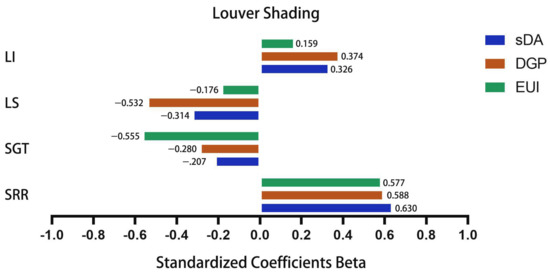
Figure 20.
Sensitivity analysis of louver shading commercial atrium SAS design parameters.
- sDA Regression equation:
Y = 0.106 + 0.969X1−0.062X2−0.095X3 + 0.004X4
- 2.
- DGP Regression equation:
Y = 0.351 + 0.274X1−0.026X2−0.049X3 + 0.001X4
- 3.
- EUI Regression equation:
Y = 632.488 + 51.824X1−9.782X2−3.095X3 + 0.119X4
4. Multi-Objective Optimization
Parametric models of buildings may generate hundreds of possible design selections. For single-objective optimal design, the influential effects between multiple objectives are often contradictory and conflicting, so the use of automatic optimization-seeking algorithms and artificial intelligence in the design process helps to solve problems faster and more accurately and find the optimal solution [28,52,63,64,65]. This investigation employs a novel parametric multi-objective optimization instrument, Octopus, since it can accomplish multi-objective optimization in a more precise and comprehensive way. Set the autonomous factors as the plan parameters of the over-sensitivity analysis and the dependent factors as sDA, DGP, and EUI. The later forms incorporate the individual calculation of the most extreme esteem of sDA and the least esteem of DGP and EUI to attain the most excellent impact of indoor daylight and energy performance, the setting of the parameters of the genetic calculation, and the ultimate multi-objective optimization calculation. The detailed parameter settings for the optimization simulation of Octopus are shown in Table 13.

Table 13.
Octopus optimized parameter settings.
4.1. No Shading Multi-Objective Optimization
After the Octopus calculation, the Pareto-front solution set was obtained, as shown in Figure 21. Based on the Pareto-front solution set and the recommended value range of the optimization target, ten sets of parameters were screened and marked in the figure, as shown in Table 14. The listed ten sets of parameters were arranged from the lowest to the highest sDA, and the optimization target values of the screening rules were: sDA was not less than 55%, DGP was not more than 45%, and on this basis, the lower the EUI, the more optimal. Among the ten groups of parameter combinations with no shading conditions, the best result in terms of comprehensive indexes is the eighth group with SRR 0.53. SGT option 4 (Double silver Low-E insulating glass) can achieve 88.89% of sDA, 45.83% of DGP, and 620.2 kWh/m2 of EUI, which is the best result for the commercial atrium with no shading. It is the ideal combination of SAS parameters to attain the maximum atrium daylight and visual comfort under the condition that the atrium meets low energy consumption.
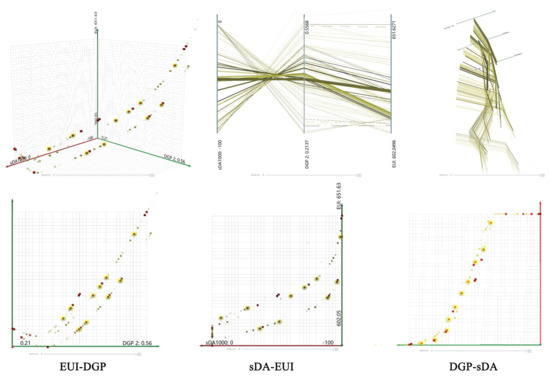
Figure 21.
Pareto frontier images of no shading commercial atrium.

Table 14.
No shading commercial atrium pareto-front solution set.
4.2. Fabric Shading Multi-Objective Optimization
After the Octopus calculation, the Pareto-front solution set was obtained, as shown in Figure 22. The detailed data is shown in Table 15. Among the ten sets of parameter combinations of fabric shading, the best result of the integrated indexes was the seventh set, with SRR of 0.54, SGT selection 4 (Double silver Low-E insulating glass), FV of 0.82, and FC of 0.44, which can achieve 82.78% of sDA, 44.49% of DGP, and 610.6 kWh/m2 of EUI. This is the ideal combination of SAS parameters to attain maximum atrium daylight and visual comfort under the condition of low energy consumption for the fabric shading commercial atrium.
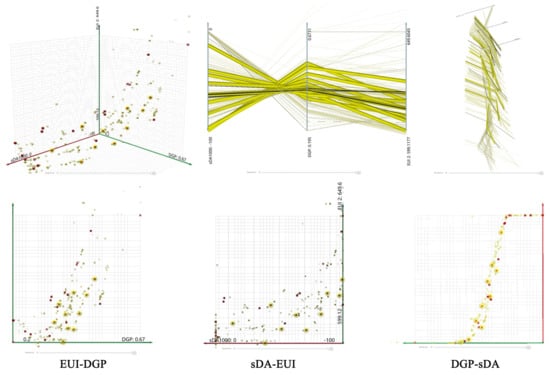
Figure 22.
Pareto frontier images of fabric shading commercial atrium.

Table 15.
Fabric shading commercial atrium pareto-front solution set.
4.3. Louver Shading Multi-Objective Optimization
After the Octopus calculation, the Pareto-front solution set was obtained, as shown in Figure 23. The specific data are shown in Table 16. Among the ten sets of parameter combinations for louver shading, the best result in terms of comprehensive indicators is the seventh set, with SRR of 0.87, SGT selection 4 (Double silver Low-E insulating glass), LS of 100 mm, and FC of 52°, which can achieve 74% of sDA, 37.96% of DGP, and an EUI of 619 kWh/m2, which is the ideal combination of SAS parameters to attain the maximum atrium lighting and visual comfort under the condition of low energy consumption for the louver shading commercial atrium.
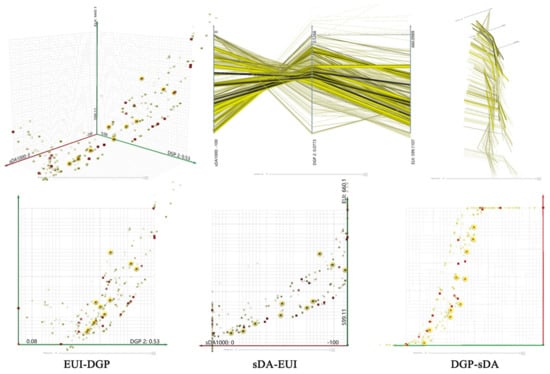
Figure 23.
Pareto frontier images of louver shading commercial atrium.

Table 16.
Louver shading commercial atrium pareto-front solution set.
5. Discussion
According to the pre-study of commercial buildings, three types of shading are commonly used in commercial atriums, namely, no shading, fabric shading, and louver shading. The shading design of skylights can reduce indoor overheating and air conditioning energy consumption caused by solar radiation, but it will also increase daylight energy consumption. Therefore, appropriate shading settings are necessary [66]. SAS design parameters were simulated for each type of commercial atrium, and a correlation analysis of each parameter was done. The results show that the correlation between SGT, LS, and sDA is relatively insignificant, while the correlation between FV, LS, and EUI is not significant. Other SAS design parameters are correlated with sDA, DGP, and EUI, indicating that SAS design parameters have different effects on daylight, visual comfort, and energy performance under different shading conditions.
Under the atrium with no shading, SRR shows a significant positive correlation with sDA, DGP, and EUI. The overall result shows that the total EUI is significantly positively correlated with SRR. SGT has a larger U-value and smaller SHGC and visible transmittance as the number increases, so it shows a significant negative correlation with DGP and EUI, and with sDA also has a linear variation pattern. Since SGT is a discrete variable, the parameters of the five skylight glass types cannot be varied individually and are correlated with each other, e.g., increasing the coating of the glass will decrease the U-value of the glass and decrease the SHGC and visible transmittance at the same time, so there may be errors in the correlation analysis due to the specificity of the parameter variables and the limited sample. As the SGT number increases, the Cooling EUI decreases significantly. However, the Heating EUI does not change much, and the Lighting EUI increases slightly, so the SGT still shows a significant negative correlation to the total EUI. Under the fabric shading atrium, FV showed a significant positive correlation with sDA and DGP, but no significant correlation with EUI because increasing FV increased the Cooling EUI and decreased the Heating and Lighting EUI, but the mutual effect resulted in no significant linear change in the total EUI with FV. The total EUI showed a negative linear correlation with FC because FC had an effect on the Cooling EUI. Under the louver shading atrium, LS showed a significant negative correlation with sDA and DGP, but as LS increased, the Lighting EUI increased significantly, and the Cooling decreased, so the total EUI was not significantly correlated with LS. LI, for example, showed a significant correlation with sDA, DGP, and EUI with clockwise rotation. From the results, it can be seen that most of the SAS design parameters are correlated with sDA and DGP, and SAS design parameters other than FV and LS have a greater influence on the Cooling EUI, which will directly produce the effect of the parameters on the total EUI.
Later, orthogonal experimental designs were conducted for the three shading methods. A multiple linear regression equation analysis was performed based on the simulation results to investigate the degree of influence of SAS design parameters on sDA, DGP, and EUI under different shading methods. The results showed that the influence of SRR on sDA, DGP, and EUI was greater under the atrium with no shading, while the influence of SGT on EUI was greater. Under fabric shade atrium, SRR and SGT still had significant effects on sDA, DGP, and EUI, while FV had a smaller effect on EUI and FC had a relatively larger effect on EUI. Under louver shading, SRR does not change much from the situation under other shading methods, while SGT has a more significant effect on EUI compared to daylight quality, while LS and LI have a greater effect on daylight quality than the effect on energy performance. The results appear that SRR has the most noteworthy impact on daylight, visual comfort, and energy performance in all shading cases; SGT incorporates an essentially more prominent effect on EUI than on daylight quality; FC encompasses an essentially more prominent impact on EUI than FV has on EUI; and LS and LI have a more noteworthy impact on daylight and visual comfort.
Finally, the parametric modeling Grasshopper and the multi-objective search tool Octopus are used to perform a multi-objective search for the three shading methods with automatic optimization calculation. The optimal solution set in the Pareto-front with no shading atrium is the eighth group with SRR of 0.53 and SGT of 4. From the observation of the ten solution sets, it can be seen that the range of values for sDA is SRR (0.5–0.6) and SGT (3–4); the range of values for DGP is SRR (0.35–0.45) and SGT (4–5); the range of values for EUI is SRR (0.35–0.45) and SGT (4–5). The optimal values are SRR (0.35–0.5) and SGT (4–5); the optimal values are SRR (0.4–0.5) and SGT (4), which are consistent with the optimal solution set. Under the fabric shading atrium, the optimal solution set in Pareto-front is the seventh group with SRR of 0.54, SGT of 4, FV of 0.82, and FC of 0.44. From the observation of the ten solution sets, it can be seen that the range of values favoring sDA is SRR (0.6–0.9), SGT (4), FV (0.7–0.8), and FC (0.5–0.7); the range of values favoring DGP is SRR (0.4–0.6), SGT (4–5), FV (0.2–0.5), and EUI (0.4–0.5); favorable EUI is SRR (0.4–0.5), SGT (4), FV (0.3–0.5), and FC (0.4–0.6); on balance the optimal range of values is SRR is 0.5 −0.6, SGT is 4, FV is 0.5–0.7, and FC is 0.5–0.6, which is a relatively good fit with the optimal solution set. Under the louver shading atrium, the optimal solution set in Pareto-front is the seventh group with SRR of 0.87, SGT of 4, LS of 3 (100 mm), and LI of 52°. From the observation of the ten solution sets, it can be seen that the range of values favoring sDA is SRR (0.7–0.9), SGT (2–4), LS (3–4), and LI (60–80°); the range of values favoring DGP is SRR (0.5–0.6), SGT (3–4), LS (4–5), and LI (70–80°); the range of values favoring EUI is SRR (0.5–0.6), SGT (4), LS (5), and LI (50–60°); on balance the optimal range of values is SRR is 0.6–0.7, SGT is 4, LS is 3–4, and LI is 60–70°, which is more consistent with the optimal solution set.
6. Conclusions
As the foremost common portion of commercial buildings, it is fundamental to form a comfortable and energy-efficient atrium for utilization. This paper investigates the impact of SAS design parameters on the daylight, visual comfort, and energy performance of commercial atriums from the viewpoint of skylight and shading design parameters. After the preliminary on-site and questionnaire research, it is found that customers have a strong subjective evaluation of the commercial atrium daylight environment, customer satisfaction of a commercial atrium is closely related to atrium daylight and visual comfort, and there is still a lot of potential to improve commercial atrium daylight environment and energy saving. SAS design parameters are explored for three different shading types of atriums respectively, and the results show that:
- Under the condition of atrium with no shading, SRR shows a significant positive correlation with sDA, DGP, and EUI, and the combined perspective is still a significant increase in Cooling EUI, while SGT shows a significant negative correlation with sDA, DGP, and EUI. From the standardized coefficients Beta, the degree of influence of SRR on sDA, DGP, and EUI is relatively large while SGT has a greater influence on EUI. After multi-objective calculations, the optimal SAS design parameters selected in the range of SRR are 0.4–0.5 and SGT are 4 (Double silver Low-E insulating glass).
- Under the fabric shading atrium condition, FV showed significant positive correlation with sDA and DGP, but no significant correlation with EUI. FC showed significant negative correlation with sDA, DGP, and EUI. From the standardized coefficients Beta, SRR and SGT still had significant effects on sDA, DGP, and EUI, while FV had a weak effect on EUI and FC had a relatively strong effect on EUI. After multi-objective calculations, the optimal SAS design parameters screened out for SRR are 0.5–0.6, SGT are 4 (Double silver Low-E insulating glass), FV is 0.5–0.7, and FC are 0.5–0.6.
- Under louver shading atrium conditions, LS showed significant negative correlation with sDA and DGP, and the total EUI showed no significant correlation with LS. LI showed significant correlation with sDA, DGP, and EUI with clockwise rotation, for example. From the standardized coefficient Beta, SRR does not change much from the case under other shading methods, while the degree of influence of SGT on EUI is more significant compared to the quality of daylight, while the influence of LS and LI in the quality of daylight is greater than the effect on energy performance. After multi-objective calculations, the optimal SAS design parameters selected in the range of SRR are 0.6–0.7, SGT are 4 (Double silver Low-E insulating glass), LS are 100 mm/125 mm, and LI are 60–70°.
The results of the study about on the impacts of SAS design parameters on daylight, visual comfort, and energy performance appear that SRR has the most prominent impact on sDA, DGP, and EUI in all shading circumstances. SGT encompasses an essentially more noteworthy effect on EUI than on daylight quality; FC incorporates an altogether more prominent impact on EUI than FV has on EUI; and LS and LI have the most noteworthy impact on daylight and visual comfort, which play a more critical part. Based on the Pareto-front arrangement set received from the multi-objective calculations, this paper provides the optimal SAS design parameters for each of the three shading types so that the best daylight, visual comfort, and energy performance can be achieved. The results of this investigation will hopefully provide some reference and data for future commercial building atrium design in cold zones.
Author Contributions
Conceptualization, Y.X. and W.L.; Methodology, Y.X.; Software, W.L.; Validation, W.L.; Formal analysis, W.L.; Investigation, W.L.; Resources, W.L.; Writing—original draft, W.L.; Writing—review & editing, Y.X.; Visualization, W.L.; Supervision, Y.X.; Project administration, Y.X. All authors have read and agreed to the published version of the manuscript.
Funding
This research received no external funding.
Data Availability Statement
Data is contained within the article or non-published material.
Conflicts of Interest
The authors declare that they have no known competing financial interests or personal relationships that could have appeared to influence the work reported in this paper.
Abbreviations
| SAS | Skylight and shading |
| sDA | Spatial Daylight Autonomy |
| ASE | Annual Sunlight Exposure |
| DGP | Daylight glare probability |
| EUI | Energy use intensity |
| SRR | Skylight roof ratio |
| SGT | Skylight glass type |
| FC | Fabric coverage |
| FV | Fabric Visible light transmittance |
| LS | Louvered size |
| LI | Louvered Inclination |
| WI | Well index |
| VT | Visible light transmittance |
| WWR | Window to wall ratio |
| DF | Daylight factor |
| UDI | Useful Daylight Illuminance |
| DA | Daylight Autonomy |
| CDA | Continuous Daylight Autonomy |
| CBDM | Climate-based daylight modeling |
| SHGC | Solar heat gain coefficient |
| DGI | Daylight Glare Index |
| UGI | Unified Glare Index |
| VCP | Visual Comfort Probability |
| CGI | CIE Glare Index |
References
- Ge, J.; Zhao, Y.; Zhao, K. Impact of a non-enclosed atrium on the surrounding thermal environment in shopping malls. J. Build. Eng. 2021, 35, 101981. [Google Scholar] [CrossRef]
- Zhao, S.; Yang, L.; Gao, S.; Li, M.; Yan, H.; Zhai, Y. Field investigation on the thermal environment and thermal comfort in shopping malls in the cold zone of China. Build. Environ. 2022, 214, 108892. [Google Scholar] [CrossRef]
- Li, D.H.W.; Cheung, A.C.K.; Chow, S.K.H.; Lee, E.W.M. Study of daylight data and lighting energy savings for atrium corridors with lighting dimming controls. Energy Build. 2014, 72, 457–464. [Google Scholar] [CrossRef]
- Xiang, X.; Ma, M.; Ma, X.; Chen, L.; Cai, W.; Feng, W.; Ma, Z. Historical decarbonization of global commercial building operations in the 21st century. Appl. Energy 2022, 322, 119401. [Google Scholar] [CrossRef]
- Dong, L.; He, Y.; Qi, Q.; Wang, W. Optimization of daylight in atrium in underground commercial spaces: A case study in Chongqing, China. Energy Build. 2022, 256, 111739. [Google Scholar] [CrossRef]
- El-Abd, W.; Kamel, B.; Afify, M.; Dorra, M. Assessment of skylight design configurations on daylighting performance in shopping malls: A case study. Sol. Energy 2018, 170, 358–368. [Google Scholar] [CrossRef]
- Aldawoud, A. The influence of the atrium geometry on the building energy performance. Energy Build. 2013, 57, 1–5. [Google Scholar] [CrossRef]
- Wang, L.; Huang, Q.; Zhang, Q.; Xu, H.; Yuen, R.K.K. Role of atrium geometry in building energy consumption: The case of a fully air-conditioned enclosed atrium in cold climates, China. Energy Build. 2017, 151, 228–241. [Google Scholar] [CrossRef]
- Xue, Y.; Liu, W. A Study on Parametric Design Method for Optimization of Daylight in Commercial Building’s Atrium in Cold Regions. Sustainability 2022, 14, 7667. [Google Scholar] [CrossRef]
- Tabesh, T.; Sertyesilisik, B. An Investigation into Energy Performance with the Integrated Usage of a Courtyard and Atrium. Buildings 2016, 6, 21. [Google Scholar] [CrossRef]
- Pilechiha, P.; Mahdavinejad, M.; Pour Rahimian, F.; Carnemolla, P.; Seyedzadeh, S. Multi-objective optimisation framework for designing office windows: Quality of view, daylight and energy efficiency. Appl. Energy 2020, 261, 114356. [Google Scholar] [CrossRef]
- Qin, R.; Yan, D.; Zhou, X.; Jiang, Y. Research on a dynamic simulation method of atrium thermal environment based on neural network. Build. Environ. 2012, 50, 214–220. [Google Scholar] [CrossRef]
- Konstantzos, I.; Tzempelikos, A. Daylight glare evaluation with the sun in the field of view through window shades. Build. Environ. 2017, 113, 65–77. [Google Scholar] [CrossRef]
- Yun, G.; Yoon, K.C.; Kim, K.S. The influence of shading control strategies on the visual comfort and energy demand of office buildings. Energy Build. 2014, 84, 70–85. [Google Scholar] [CrossRef]
- Palmero-Marrero, A.I.; Oliveira, A.C. Effect of louver shading devices on building energy requirements. Appl. Energy 2010, 87, 2040–2049. [Google Scholar] [CrossRef]
- Kirimtat, A.; Koyunbaba, B.K.; Chatzikonstantinou, I.; Sariyildiz, S. Review of simulation modeling for shading devices in buildings. Renew. Sustain. Energy Rev. 2016, 53, 23–49. [Google Scholar] [CrossRef]
- Grynning, S.; Time, B.; Matusiak, B. Solar shading control strategies in cold climates—Heating, cooling demand and daylight availability in office spaces. Sol. Energy 2014, 107, 182–194. [Google Scholar] [CrossRef]
- Mavridou, T.; Doulos, L. Evaluation of Different Roof Types Concerning Daylight in Industrial Buildings during the Initial Design Phase: Methodology and Case Study. Buildings 2019, 9, 170. [Google Scholar] [CrossRef]
- Galal, K.S. The impact of atrium top materials on daylight distribution and heat gain in the Lebanese coastal zone. Alex. Eng. J. 2019, 58, 659–676. [Google Scholar] [CrossRef]
- Aldawoud, A.; Clark, R. Comparative analysis of energy performance between courtyard and atrium in buildings. Energy Build. 2008, 40, 209–214. [Google Scholar] [CrossRef]
- Calcagni, B.; Paroncini, M. Daylight factor prediction in atria building designs. Sol. Energy 2004, 76, 669–682. [Google Scholar] [CrossRef]
- Wu, P.; Zhou, J.; Li, N. Influences of atrium geometry on the lighting and thermal environments in summer: CFD simulation based on-site measurements for validation. Build. Environ. 2021, 197, 107853. [Google Scholar] [CrossRef]
- Wang, F.; Pichatwatana, K.; Roaf, S.; Zhao, L.; Zhu, Z.; Li, J. Developing a weather responsive internal shading system for atrium spaces of a commercial building in tropical climates. Build. Environ. 2014, 71, 259–274. [Google Scholar] [CrossRef]
- Le-Thanh, L.; Nguyen-Thi-Viet, H.; Lee, J.; Nguyen-Xuan, H. Machine learning-based real-time daylight analysis in buildings. J. Build. Eng. 2022, 52, 104374. [Google Scholar] [CrossRef]
- Laouadi, A.; Atif, M.R.; Galasiu, A. Methodology towards developing skylight design tools for thermal and energy performance of atriums in cold climates. Build. Environ. 2003, 38, 117–127. [Google Scholar] [CrossRef]
- Hsu, H.-H.; Chiang, W.-H.; Huang, J.-S. Hybrid Ventilation in an Air-Conditioned Office Building with a Multistory Atrium for Thermal Comfort: A Practical Case Study. Buildings 2021, 11, 625. [Google Scholar] [CrossRef]
- Rastegari, M.; Pournaseri, S.; Sanaieian, H. Daylight optimization through architectural aspects in an office building atrium in Tehran. J. Build. Eng. 2021, 33, 101718. [Google Scholar] [CrossRef]
- Mohsenin, M.; Hu, J. Assessing daylight performance in atrium buildings by using Climate Based Daylight Modeling. Sol. Energy 2015, 119, 553–560. [Google Scholar] [CrossRef]
- Almodóvar-Melendo, J.-M.; Quesada-García, S.; Valero-Flores, P.; Cabeza-Lainez, J. Solar Radiation in Architectural Projects as a Key Design Factor for the Well-Being of Persons with Alzheimer’s Disease. Buildings 2022, 12, 603. [Google Scholar] [CrossRef]
- Motamedi, S.; Liedl, P. Integrative algorithm to optimize skylights considering fully impacts of daylight on energy. Energy Build. 2017, 138, 655–665. [Google Scholar] [CrossRef]
- Acosta, I.; Varela, C.; Molina, J.F.; Navarro, J.; Sendra, J.J. Energy efficiency and lighting design in courtyards and atriums: A predictive method for daylight factors. Appl. Energy 2018, 211, 1216–1228. [Google Scholar] [CrossRef]
- Bellazzi, A.; Danza, L.; Devitofrancesco, A.; Ghellere, M.; Salamone, F. An artificial skylight compared with daylighting and LED: Subjective and objective performance measures. J. Build. Eng. 2022, 45, 103407. [Google Scholar] [CrossRef]
- Webb, A.R. Considerations for lighting in the built environment: Non-visual effects of light. Energy Build. 2006, 38, 721–727. [Google Scholar] [CrossRef]
- De Luca, F.; Sepúlveda, A.; Varjas, T. Multi-performance optimization of static shading devices for glare, daylight, view and energy consideration. Build. Environ. 2022, 217, 109110. [Google Scholar] [CrossRef]
- Abdullah, A.H.; Meng, Q.; Zhao, L.; Wang, F. Field study on indoor thermal environment in an atrium in tropical climates. Build. Environ. 2009, 44, 431–436. [Google Scholar] [CrossRef]
- Li, L.; Qu, M.; Peng, S. Performance evaluation of building integrated solar thermal shading system: Building energy consumption and daylight provision. Energy Build. 2016, 113, 189–201. [Google Scholar] [CrossRef]
- Freewan, A.A.Y. Impact of external shading devices on thermal and daylighting performance of offices in hot climate regions. Sol. Energy 2014, 102, 14–30. [Google Scholar] [CrossRef]
- De Loyola Ramos Garcia, D.; Ruttkay Pereira, F.O. Method application and analyses of visual and thermal-energy performance prediction in offices buildings with internal shading devices. Build. Environ. 2021, 198, 107912. [Google Scholar] [CrossRef]
- Bueno, B.; Wilson, H.R.; Sunkara, S.; Sepúlveda, A.; Kuhn, T.E. Simulation-based design of an angle-selective and switchable textile shading system. Build. Environ. 2020, 184, 107227. [Google Scholar] [CrossRef]
- Katsifaraki, A.; Bueno, B.; Kuhn, T.E. A daylight optimized simulation-based shading controller for venetian blinds. Build. Environ. 2017, 126, 207–220. [Google Scholar] [CrossRef]
- Konstantoglou, M.; Tsangrassoulis, A. Dynamic operation of daylighting and shading systems: A literature review. Renew. Sustain. Energy Rev. 2016, 60, 268–283. [Google Scholar] [CrossRef]
- Nielsen, M.V.; Svendsen, S.; Jensen, L.B. Quantifying the Potential of Automated Dynamic Solar Shading in Office Buildings through Integrated Simulations of Energy and Daylight. Sol. Energy 2011, 85, 757–768. [Google Scholar] [CrossRef]
- Day, J.K.; Futrell, B.; Cox, R.; Ruiz, S.N.; Amirazar, A.; Zarrabi, A.H.; Azarbayjani, M. Blinded by the light: Occupant perceptions and visual comfort assessments of three dynamic daylight control systems and shading strategies. Build. Environ. 2019, 154, 107–121. [Google Scholar] [CrossRef]
- Koç, S.G.; Kalfa, S.M. The effects of shading devices on office building energy performance in Mediterranean climate regions. J. Build. Eng. 2021, 44, 102653. [Google Scholar] [CrossRef]
- Mayhoub, M.S.; Rabboh, E.H. Daylighting in shopping malls: Customer’s perception, preference, and satisfaction. Energy Build. 2022, 255, 111691. [Google Scholar] [CrossRef]
- Dai, B.; Tong, Y.; Hu, Q.; Chen, Z. Characteristics of thermal stratification and its effects on HVAC energy consumption for an atrium building in south China. Energy 2022, 249, 123425. [Google Scholar] [CrossRef]
- Ghaleb, B.; Asif, M. Application of solar PV in commercial buildings: Utilizability of rooftops. Energy Build. 2022, 257, 111774. [Google Scholar] [CrossRef]
- Asfour, O.S. A comparison between the daylighting and energy performance of courtyard and atrium buildings considering the hot climate of Saudi Arabia. J. Build. Eng. 2020, 30, 101299. [Google Scholar] [CrossRef]
- Fan, Z.; Liu, M.; Tang, S. A multi-objective optimization design method for gymnasium facade shading ratio integrating energy load and daylight comfort. Build. Environ. 2022, 207, 108527. [Google Scholar] [CrossRef]
- Ziaee, N.; Vakilinezhad, R. Multi-objective optimization of daylight performance and thermal comfort in classrooms with light-shelves: Case studies in Tehran and Sari, Iran. Energy Build. 2022, 254, 111590. [Google Scholar] [CrossRef]
- Khidmat, R.P.; Fukuda, H.; Kustiani; Paramita, B.; Qingsong, M.; Hariyadi, A. Investigation into the daylight performance of expanded-metal shading through parametric design and multi-objective optimisation in Japan. J. Build. Eng. 2022, 51, 104241. [Google Scholar] [CrossRef]
- Wu, H.; Zhang, T. Multi-objective optimization of energy, visual, and thermal performance for building envelopes in China’s hot summer and cold winter climate zone. J. Build. Eng. 2022, 59, 105034. [Google Scholar] [CrossRef]
- Razmi, A.; Rahbar, M.; Bemanian, M. PCA-ANN integrated NSGA-III framework for dormitory building design optimization: Energy efficiency, daylight, and thermal comfort. Appl. Energy 2022, 305, 117828. [Google Scholar] [CrossRef]
- Danielski, I.; Nair, G.; Joelsson, A.; Fröling, M. Heated atrium in multi-storey apartment buildings, a design with potential to enhance energy efficiency and to facilitate social interactions. Build. Environ. 2016, 106, 352–364. [Google Scholar] [CrossRef]
- Li, J.; Ban, Q.; Chen, X.; Yao, J. Glazing Sizing in Large Atrium Buildings: A Perspective of Balancing Daylight Quantity and Visual Comfort. Energies 2019, 12, 701. [Google Scholar] [CrossRef]
- Vethanayagam, V.; Abu-Hijleh, B. Increasing efficiency of atriums in hot, arid zones. Front. Arch. Res. 2019, 8, 284–302, Erratum in Front. Arch. Res. 2019, 10, 224–225. [Google Scholar] [CrossRef]
- Brembilla, E.; Chi, D.A.; Hopfe, C.J.; Mardaljevic, J. Evaluation of climate-based daylighting techniques for complex fenestration and shading systems. Energy Build. 2019, 203, 109454. [Google Scholar] [CrossRef]
- Sudan, M.; Mistrick, R.G.; Tiwari, G. Climate-Based Daylight Modeling (CBDM) for an atrium: An experimentally validated novel daylight performance. Sol. Energy 2017, 158, 559–571. [Google Scholar] [CrossRef]
- Suk, J.Y. Luminance and vertical eye illuminance thresholds for occupants’ visual comfort in daylit office environments. Build. Environ. 2019, 148, 107–115. [Google Scholar] [CrossRef]
- Wienold, J.; Christoffersen, J. Evaluation methods and development of a new glare prediction model for daylight environments with the use of CCD cameras. Energy Build. 2006, 38, 743–757. [Google Scholar] [CrossRef]
- Cao, X.; Yao, R.; Ding, C.; Zhou, N.; Yu, W.; Yao, J.; Xiong, J.; Xu, Q.; Pan, L.; Li, B. Energy-quota-based integrated solutions for heating and cooling of residential buildings in the Hot Summer and Cold Winter zone in China. Energy Build. 2021, 236, 110767. [Google Scholar] [CrossRef]
- Shen, H.; Tzempelikos, A. Sensitivity analysis on daylighting and energy performance of perimeter offices with automated shading. Build. Environ. 2013, 59, 303–314. [Google Scholar] [CrossRef]
- Yi, Y.K.; Tariq, A.; Park, J.; Barakat, D. Multi-objective optimization (MOO) of a skylight roof system for structure integrity, daylight, and material cost. J. Build. Eng. 2021, 34, 102056. [Google Scholar] [CrossRef]
- Zhu, L.; Wang, B.; Sun, Y. Multi-objective optimization for energy consumption, daylighting and thermal comfort performance of rural tourism buildings in north China. Build. Environ. 2020, 176, 106841. [Google Scholar] [CrossRef]
- Marzouk, M.; ElSharkawy, M.; Mahmoud, A. Optimizing daylight utilization of flat skylights in heritage buildings. J. Adv. Res. 2022, 37, 133–145. [Google Scholar] [CrossRef] [PubMed]
- Katunský, D.; Vertaľ, M.; Dolníková, E.; Zozuláková, S.; Hutkai, K.; Dická, Z. Mutual Interaction of Daylight and Overheating in the Attic Space in Summer Time. Sustainability 2022, 14, 15634. [Google Scholar] [CrossRef]
Disclaimer/Publisher’s Note: The statements, opinions and data contained in all publications are solely those of the individual author(s) and contributor(s) and not of MDPI and/or the editor(s). MDPI and/or the editor(s) disclaim responsibility for any injury to people or property resulting from any ideas, methods, instructions or products referred to in the content. |
© 2023 by the authors. Licensee MDPI, Basel, Switzerland. This article is an open access article distributed under the terms and conditions of the Creative Commons Attribution (CC BY) license (https://creativecommons.org/licenses/by/4.0/).